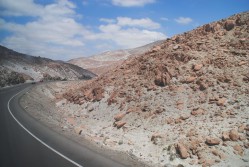
With a total land area just a hair under 500,000 square miles, Peru is somewhere between the U.S. states of Texas and Alaska in size. Although significantly smaller than several of its South American compadres, it is a very large country, 20th in the world by area.
As is the case through much of the rest of supersized South America, travel options within Peru are many — but only a handful of these options make sense to budget travelers and backpackers. Getting around in Peru is cheap and relatively painless if you’re flexible and willing to travel overland.

Traveling through Peru by bus ensures you don’t miss any breathtaking scenery.
Bus Travel in Peru
Buses are by far the most popular way to travel within Peru, for locals and tourists alike. Prices vary depending on the distance you travel and the class of service, but are among the cheapest in South America.
Likewise, whether you choose a standard semi-cama seat or a lie-flat(ish) cama bed, the comfort of buses in Peru is almost second to none, except for maybe Argentina. Popular long-distance bus companies in Peru include Cial, Ormeño and Cruz del Sur which is, in my opinion, the best of them all.
Public buses exist within Lima. In other cities, you’ll have to stick to taxis and collectivos, taxis shared by multiple passengers you can think of as small buses.

Both major train companies in Peru operate services to Aguascalientes, at the base of Machu Picchu.
Trains in Peru
Although Peru’s rail network is far from sophisticated, it is arguably among the best developed and maintained in South America, particularly for tourists. Specifically, the two companies that operate trains in Peru — PeruRail and Inca Rail — operate only along popular tourist routes.
PeruRail’s network is more extensive, relatively speaking. PeruRail trains run from the city center of Cusco to the Sacred Valley of the Incas, and then on to Machu Picchu. IncaRail, on the other hand, operates trains only between Machu Picchu and Ollantaytambo.
I traveled on both type of Peru trains: I took PeruRail from Ollantaytambo to Machu Picchu (the station for which is technically in the nearby town of Aguascalientes); and IncaRail back the other way. Although there isn’t much discernable difference in the quality of service, Inca Rail is almost twice as expensive as PeruRail — about $100 one way vs. $40 — and as a result, has more reliable availability. If you don’t book in advance, you’ll probably end up taking Inca Rail.

I recommend leaving flying in Peru to creatures with wings.
Flights in Peru
I advise against taking flights in South America for travel wholly within Peru. Although cheap-ish fares can be found (the Loki Hostel in Lima had a flight to Arequipa for under $100), they are still almost always more expensive than buses.
But don’t buses take longer? Well, of course they do. But they’re also extremely comfortable and allow you to experience scenery that would literally pass right under your nose if you were flying. The bus journey from Lima to Arequipa was one fo the most incredible experiences of my life — the transition from the seaside cliffs of Lima to the strange desert dunes of Ica into the dusty valley where Arequipa sits was mind-blowing.

Taxis are about the only way to get in Peruvian cities other than Lima.
Private Transportation in Peru
Many private transport options exist in Peru, primarily for those travelers who want to travel by tour. In some instances there is no other option, such as for the journey from Arequipa to the Colca Canyon, located so high into the Andes that public buses don’t exist. It’s also possible to hire a taxi or bus from the town of Aguascalientes up to Machu Picchu.

Robert Schrader is a travel writer and photographer who’s been roaming the world independently since 2005, writing for publications such as “CNNGo” and “Shanghaiist” along the way. His blog, Leave Your Daily Hell, provides a mix of travel advice, destination guides and personal essays covering the more esoteric aspects of life as a traveler.








